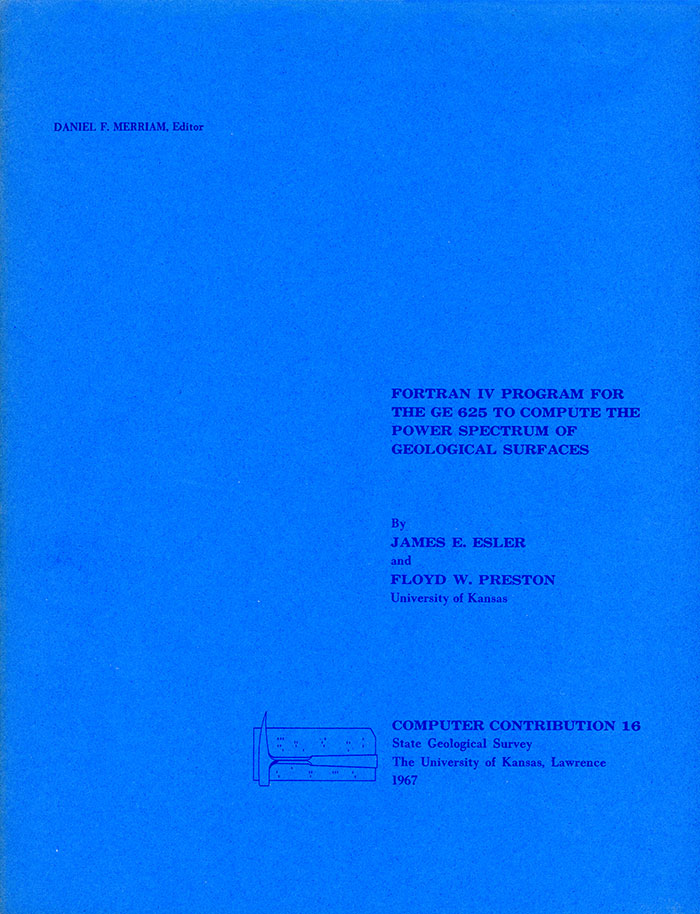
Kansas Geological Survey, Computer Contributions 16, originally published in 1967
University of Kansas

Originally published in 1967 as Kansas Geological Survey Computer Contributions 16.
Geologists and geographers have always been interested in the description and characterization of surfaces. Methods used to date mainly have been written descriptions and mathematical approximations. In the first category are discussions of landforms by early geologists and geographers. These were poetic and pictorial, but not useful in an operational sense. Descriptions by one investigator could not, in general, be used by another investigator to reconstruct a three-dimensional likeness of the surface.
To overcome the inadequacies of verbal descriptions, earth scientists have turned to numerical approximations of surfaces. These possess a degree of objectivity not present in verbal accounts, and are consistent and reproducible by other investigators. Statistics of numerically defined surfaces can be computed, and the surfaces can be compared by numerical techniques.
Least squares is the most widely used surface-fitting criterion, although there are others such as minimax and absolute deviation criteria. Mathematical models fitted to observed surfaces by least squares include polynomial and Fourier series approximations. Excellent reviews of these forms are given by Krumbein (1966a, 1966b) and James (1966).
All presently used mathematical representations of surfaces built around the least-squares criterion are based on the general linear regression model. A geologic surface is considered to be composed of a regional component (trend) and a residual component. The residual component in turn is composed of a local variation confounded with random error. Components are separated by the regression as a means of estimating variances in the surface due to regional effects and local effects, random fluctuation or error being neglected. In some geologic studies this assumption seems reasonable, as in trend-surface mapping of well-log data where random measurement errors are extremely small compared to other factors influencing the surface. If the residuals do not contain systematic variations, the trend is assumed to contain all geologically significant variation (regional and local) and represents an appropriate generalization of the surface.
Utility of the general linear regression model for description of geologic surfaces depends upon the ability of the investigator to determine the point where regional and residual components are most effectively separated.
Well-conceived methods have been presented to determine the order of an equation necessary to describe major elements of a surface. Despite impressive efforts in trend analysis there is growing uneasiness as to the appropriate interpretation of "trend, " particularly when surfaces of high order are generated. The basic problem is distinguishing between "trend" and "random" components. In the phraseology of electronics engineering, these elements would be called "signal" and "noise." In this regard, an admonition from the electronics engineer may be cited: if one wishes to extract signal from noise, one must know, a priori, the inherent nature of either the signal or-the noise. This a priori insight does not seem to be available for most geological and geographical surfaces.
Another model, which assumes the surface to have little or no "trend" above a first- or possibly a second-degree polynomial, may be considered. The observed surface essentially is noise superimposed upon this weak trend. The noise or variability is a fundamental characteristic of the surface and is considered both necessary and sufficient for description of the surface. Surfaces that are similar are assumed to have similar variabilities; surfaces with different variabilities are assumed to be different. This supposes that judgments of similarity based on variability agree with judgments of similarity made by conventional visual inspection. The measure of variability used is the power spectrum.
In this model, the surface is considered to be oscillatory or undulating in two perpendicular directions such as east-west and north-south. Within a given frequency band for these oscillations, all frequencies are considered present. The power spectrum measures the relative contribution of each frequency to the variability or oscillatory nature of the surface.
Read the PDF version (6 MB)
Kansas Geological Survey
Placed on web Aug. 27, 2019; originally published 1967.
Comments to webadmin@kgs.ku.edu
The URL for this page is http://www.kgs.ku.edu/Publications/Bulletins/CC/16/index.html